Special Supplement
Plant-based protein market offers potential for product, processing innovation
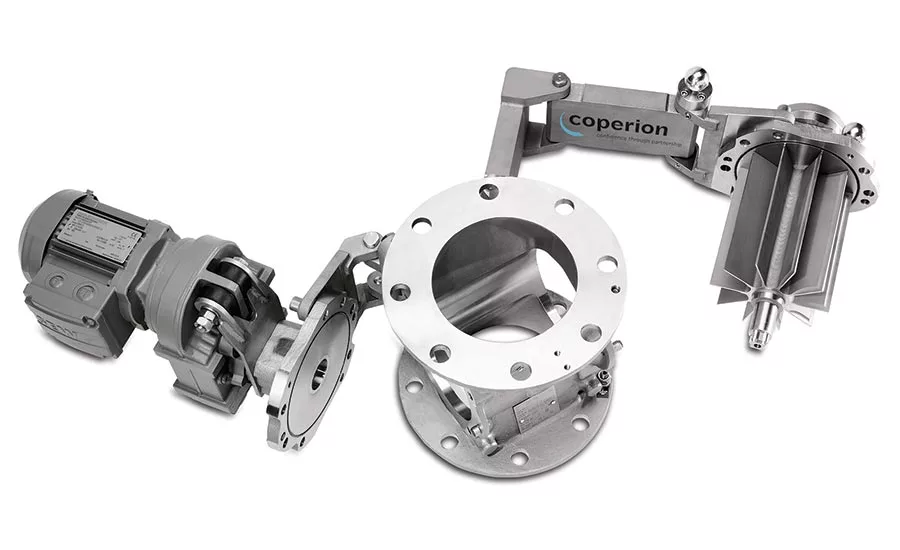
These ZRD rotary valves are designed for sanitary food applications where contamination is a concern and frequent disassembly and cleaning is required. They include a full access extraction system and a large inlet for high filling efficiency.
Photo courtesy of Coperion
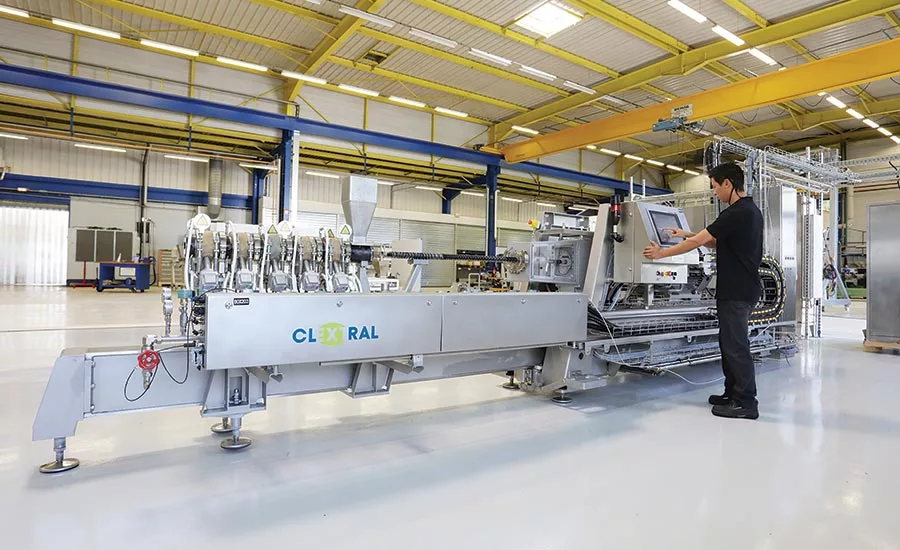
The barrel on this twin screw extruder is open for cleaning. The unit is suitable for plant-based protein processing by offering throughput, flexibility and control while ensuring maximum product quality and process stability.
Image courtesy of Clextral
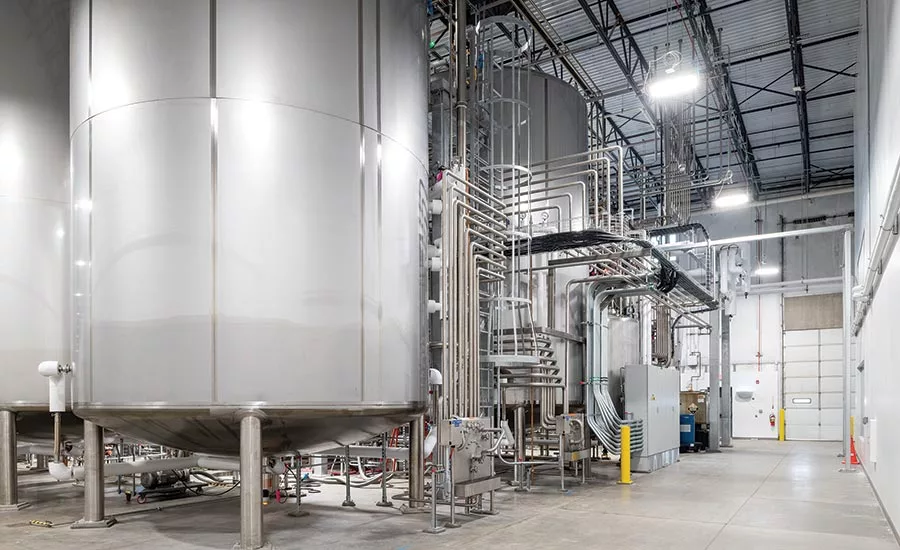
MycoTechnology takes on the challenges faced by the plant-based protein industry using mushroom fermentation in large fermentation tanks.
Photo courtesy of MycoTechnology
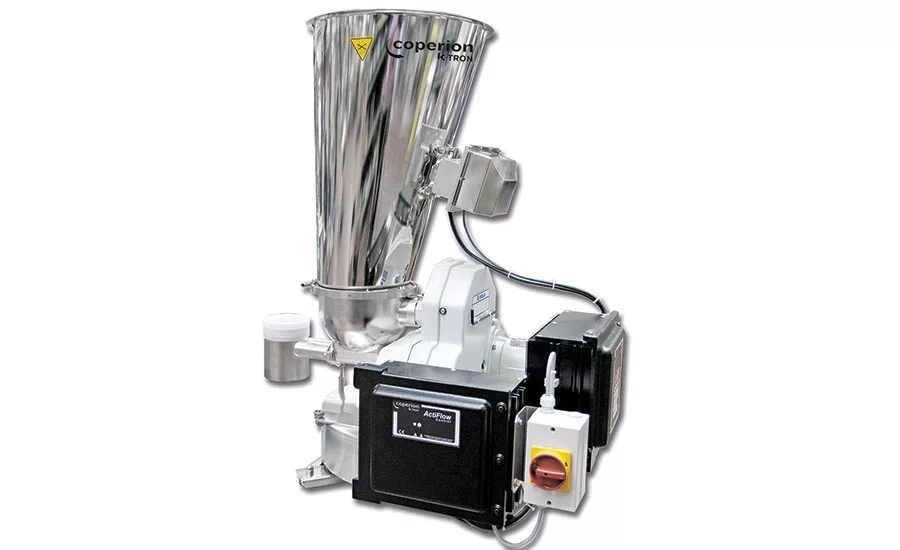
A twin screw feeder with hopper agitation specifically addresses and enhances continuous flow in the loss-in-weight feeder.
Photo courtesy of Coperion
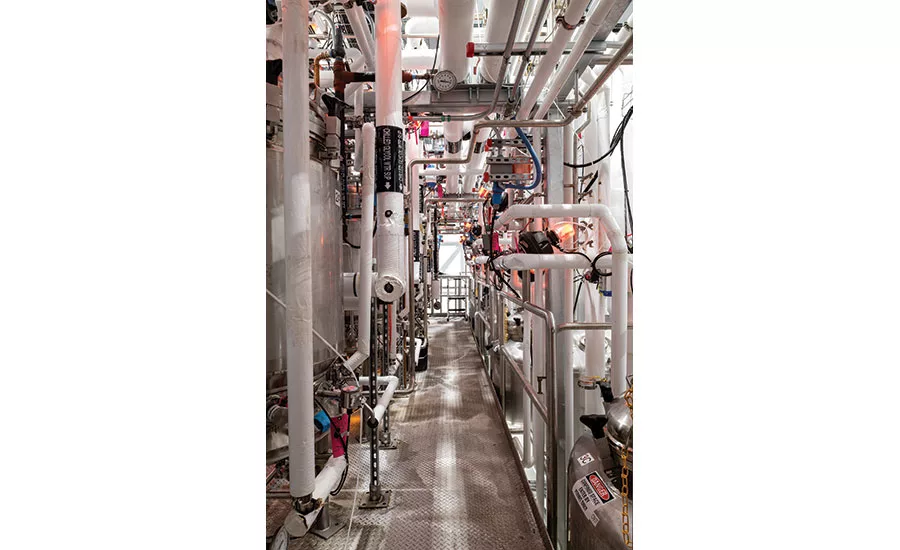
Clean-in-place technology is leveraged by MycoTechnology in the production of a shiitake mushroom fermented protein.
Photo courtesy of MycoTechnology
The plant-based protein segment continues to grow at a rapid pace. Just since the beginning of this year, several food giants have either added plant-based recipes or entered this market space with new plant-based products.
In January, Impossible Foods began selling pork and sausage made from plants—the first new products since its Impossible Burger launched in 2016; Tofurky offered a patty made of soy protein, vegetable protein and wheat gluten; and Trader Joe’s introduced its own plant-based burger made from a combination of pea protein, sunflower oil, beets and seasonings. Kellogg’s Incogmeato launched its plant-based grilling offerings under the MorningStar Farms brand in February. That same month, Cargill entered the plant-based protein game with its burgers and ground products, and Maple Leaf Foods ramped up its breakfast foods with plant-based sausages under its Lightlife and Field Roast brands.
Most recently the Brazilian meat processor JBS announced its new product line made from a pea and rice protein fermented with shiitake mushrooms will hit the store shelves in April under the Ozo brand. All of these product launches have occurred in the first quarter of 2020.
“As one of the fastest growing applications in the food industry, the plant protein market in general is quickly becoming very competitive,” says Sharon Nowak, global business development manager, food and pharmaceutical industries, at Coperion/Coperion K-Tron equipment manufacturer.
John Sheehy, global plant proteins industry manager at Coperion/Coperion K-Tron, says, “Although the industry is small, it offers a tremendous amount of potential in product innovation. For this reason, it is important for developers of plant protein products or those that simply handle and/or package plant proteins to align with equipment manufacturers who have extensive experience in the material handling and processing of these products.”
Sylvie Brunel, product and process development manager at Clextral, a turnkey processing line provider, says although the market is small compared to animal protein (meat and dairy), it is growing rapidly. “According to data from the Plant Based Foods Association and Good Food Institute, U.S. retail sales of plant-based foods grew 11% in 2019 to a market value of $4.5 billion, with plant-based meats driving the category growth with a sales increase of 37%. A 2019 report by Bank of America Merrill Lynch stated two-thirds of surveyed consumers had purchased plant-based protein products,” she says.
Sow Before You Reap
When considering entry to the plant-based protein segment, Jesse Schultz, project manager at Stellar, a design, engineering, construction and mechanical services company, says the first thing his team asks is, “Where are you in the research and development process?” He says there’s a big difference between having an idea and having a product.
Michael Mittelsteadt, process engineer at Stellar, says, “You don’t want to build a facility before knowing what your processing is going to look like. You need to develop your recipe first, because you don’t want to be drastically altering your process after your facility has already been designed.”
Once you know what your recipe and your processing needs are, then you can start budgeting with an eye toward profitability. Although plant-based foods tend to have a comfortable margin, projections for how much production capacity you need are still driven by current and projected sales totals. That information helps determine your equipment costs as well.
When it comes to defining your production needs, the individual process steps are relatively well known. But it’s still a unique process overall, says Paul Thamann, senior project architect at Hixson Architecture & Engineering.
“Depending on where you are in the facility, it may seem more like a bakery or meat plant or a prepared foods facility,” he says. “Facilities for plant-based proteins combine the dust and airborne allergen concerns of a bakery, with the raw and ready-to-eat (RTE) separation of a meat plant, and the unique raw ingredient list that would rival a prepared foods facility. Put them all together and you’re dealing with a very unique process and plenty to consider when designing the entire facility.”
Mittelsteadt says plant-based protein and traditional meat facilities have a lot of similar equipment, but the plant-based facilities often include baking equipment as well.
“The equipment in a plant-based protein facility can really be a fusion of dairy, bakery and meat equipment in one space,” says Mittelsteadt. “Plus, since this equipment is established, they’re already designed to meet food safety standards.”
Tom Rychlewski, food and beverage core team leader at CRB, an engineering, architecture, construction and consulting company, says if a producer is new to the food and beverage industry, people first need to be comfortable with the good manufacturing practices for this market.
“We can’t underestimate having a thorough understanding of allergens and contaminants and how to properly address them,” he says. “Understand hygienic design principles. Cleanability is key in this industry. Your facility should be easy to clean, but even more importantly, easy to inspect by the necessary regulating bodies.”
It is important to understand what the drivers are for entering the plant-based proteins market and carefully consider what changes you would need to make to your facility. If it’s a new product, a study to identify the needed modifications is probably a good idea. The firm conducting the study should help identify any potential new allergens or contaminants, as well as how to control them. A financial study is also an important element of making a large investment to change over or build a new facility.
“Everyone wants to go as fast as possible,” Rychlewski says. “It can feel like a race, but it’s important to have a plan before jumping in.”
Ask yourself: Can you scale your current process or do you need to consider changes such as more automation, different equipment, alternative ingredients, etc., to reach your goals?
It’s also important to know where you want to grow your company. A local or regional product requires different budget considerations than a global product.
“Established traditional protein or food manufacturing companies pivoting to a plant-based product will usually have a solid business plan with viability established already,” says Drew Goodall, director of process at Gray Solutions, a Gray company, engineering, design, and construction firm.
Bill Aimutis, executive director of the North Carolina Food Innovation Lab, offers another perspective to keep in mind.
“Be certain to pick a crop with a sizeable supply chain already in place or one that could be expanded relatively quickly,” he says. “Too often companies interested in entering the plant-based protein base are more focused on novelty than if the crop is genetically stable or sizeable enough to meet demand.”
Cultivating Equipment Considerations
There is a lot to consider from a design and operational standpoint when producing plant-based protein. Brunel explains that when talking about processed plant protein, food processors should know there are two types: dry and wet. The dry process makes dry texturized vegetable protein (TVP) products used as meat extenders and vegetarian meat substitutes. The wet process makes meat analogs with the characteristics of animal meat. There are different processes for each in terms of equipment/lines, process, raw material and processing environment.
“Once the meat analog is made with the extruder, the further processing techniques are quite similar to those of traditional meat processing,” says Brunel. “This makes the plant-based meat market very accessible to meat processors, as they have this technology already in place and can more easily add meal-ready vegetarian meats to their product lines.”
For the dry texturization process (TVP), Brunel says the following equipment is needed: mixing unit, preconditioner may be used or not depending on the raw material, extruder, short die and dryer.
For wet extrusion (meat analog), she lists the following: mixing unit, extruder (longer machine), long thermoregulated die that creates the meat texture. “The extrusion process makes fibrous meat analogs in continuous lengths, and these products are further processed (size/reduction/cutting/shredding/marinating) to create the final meal-ready plant-based meats,” she says.
Coperion’s Nowak says that it is important when designing the overall functions of the equipment that final layout includes as much added versatility and ability to do quick product changeovers as possible. For example, the Coperion hybrid extruder can accomplish both HMMA and texturized protein with quick and minimal changeover.
A big issue is the waste streams that are created as a result of plant-based protein production. Some of the byproduct can be reused, but a source that can handle those waste streams is required.
“For example, the production of tofu produces a lot of byproduct ‘waste’ that can be repurposed,” Mittelsteadt says. “But that involves finding a partner who can utilize those waste streams. This kind of waste isn’t something many waste disposal sites will take in or that municipalities want going down their sewer drains, especially because a dedicated plant-based protein facility produces a high volume of this waste.”
Material handling
As Nowak points out, “plant-based protein ingredients can range in a variety of material handling characteristics, from free flowing to difficult and cohesive.” When handling these on an automated production scale for both packaging operations or for extrusion-based products, she says it is important to optimize the equipment to facilitate the process.
For example, many plant-based protein powders are produced during a spray drying process. She also notes that Coperion’s feeding and material handling equipment has always been able to handle difficult flowing materials, such as sticky or cohesive plant based powders (e.g., pea or soy protein) and subsequent blends with difficult flowing flavors and additives. The company also has a range of system and component options that are designed to address poor flowing products.
“A perfect example of this is the new Smart Glide Finishing (SGF) anti-stick surface treatment option for our rotary valves, which prevents sticking and glazing of difficult ingredients directly to the valves,” she says.
Coperion’s Sheehy says it is important to note that besides soy and pea protein sources, there are a great variety of additional plant proteins that are being investigated for use in a range of products.
“These include, but are not limited to, other pulse proteins, such as lentil and chickpeas, mung bean, goji berries and even mushrooms and fungi,” Sheehy says. “The versatility of the equipment to handle all of these different powders is crucial.”
Brunel notes that quality and type of raw materials and recipes have a huge impact on the quality of the final product.
“When designing the base product, we need to take into account some limitations in terms of protein content; it needs to be at least over 50% of the dry base. Some minor ingredients, such as starch, fibers and other texturing agents, can be added to facilitate the processing of the protein mix and add other characteristics. Adjusting and fine-tuning these elements is essential and based on an understanding of the process and ingredients.”
Mittelsteadt says that the variances in ingredients can be accounted for by tailoring the process to the product.
“One of the biggest themes we’ve encountered are the different controls needed in order to achieve the texture and taste that the client is looking for in their plant-based protein,” he says
In terms of the processing itself, there isn’t a lot difference between processing meat and plant-based protein. Schultz says that a lot of the requirements related to temperature, cleanliness, washdowns and other risks are better defined in the meat market since it’s been around a lot longer.
“In the relatively new plant-based market, there’s still a lot of testing going on and a lot of unknowns at stake. Yes, you still have to clean, but how often? And with what? You still have to control times and temperatures, but these standards are a lot less established.”
Upstream, Downstream
Thamann agrees, saying that the raw ingredient and front-end formulations are where the biggest differences appear. Plant based-products typically contain more ingredients than meat, including blown-in bulk proteins or frozen vegetables. All of these relatively diverse ingredient types make for a multitude of raw ingredient storage conditions, material handling needs and allergen cross-contamination risks.
“At the front end of the facility, one might think they’d walked into a facility making a dozen different SKUs of TV dinners,” he says.
Gray’s Goodall says that food safety is still key, and these facilities and processes are still designed with many of the key aspects of a traditional protein plant, such as clear separation of raw and ready-to-eat processes.
“With dry, powder-based protein base ingredients (such as soy or pea powders), there must be a significant dry ingredient handling system upstream of the mixing operations,” he says. “These systems must be designed with effective separation from wet processing areas and adequate dust management equipment and cleaning protocols.
Rychlewski says that downstream, much of the equipment is similar to non-plant-based equipment, including meat grinding, patty forming, bulk conveyors, etc.
“Plant-based protein production can involve a complex upstream process with varying equipment,” he says. “Many producers are taking processes commonly seen in the biotech and industrial bio markets and applying them in food production. For example, heme for the Impossible Burger is produced through a fermentation process, and MycoTechnology is using a mushroom fermentation process to produce plant-based protein. We’re noticing better products in this evolving market because they’re dramatically changing the approach.”
Challenges to Harvest
The biggest challenges to note when considering entering the plant-based protein market include the material handling of powders, often with difficult flowability characteristics; organic combustible powder handling; producing quality plant protein products with the required textures and flavors to compete with meat products; engineering process lines, which include enough flexibility to address the growing innovation trends of the market and maximize profitability; and designing for quick product changeovers while maintaining optimal food and process safety.
Nowak says, “One of the most important factors in processing plant proteins as opposed to meat processing is the high percentage of powder handling required in plant protein operations. Since many of these ingredient powders are organic, there is also a higher safety risk for the presence of combustible dusts.”
MIE’s (or the minimum energy required to ignite) can also change significantly when dealing with the same material but smaller powder particle sizes, and she notes that it is important when designing a system for the transfer of these powders, whether from the spray dryer to the packaging line, or from the bulk bags to the feeders above a mixer and/or extruder, that the systems provider chosen outline all the possible design parameters to ensure safe operation.
Powder handling concerns also extend to allergens and other contaminants. Handling them properly is critical to developing a safe, effective process.
“Know your allergens and your plan to mitigate their cross-contamination,” says Hixson’s Thamann. “If your goal is to have zero allergen claims on your packaging, it will come at a premium cost to your facility in the form of duplicated and segregated spaces to maintain allergen separation from raw materials to package.”
Rychlewski says one of the biggest challenges is getting product to market as fast as possible without compromising quality. Everyone wants to be the first to market, but it’s vital to understand the risks and have the most qualified and capable partner to guide you through the process.
“Producing plant-based protein requires complex equipment and processes. Don’t compromise on quality by selecting a contractor who may not have the necessary experience and doesn’t understand the complexities of FDA and USDA facility design. Have confidence that when your equipment arrives on site, it will be correct and you aren’t spending six months to a year correcting mistakes to get your facility up and running.”
And Goodall says the biggest challenge associated with processing a plant-based protein is scaling up new ideas to a commercially viable product. “Scale is key—many companies have figured out the tastes/textures that consumers prefer, but then price point is the final hurdle.”
For more information:
Clextral, www.clextral.com
Coperion, www.coperion.com
CRB, www.crbusa.com
NC Food Innovation Lab, www.ncfoodinnovationlab.org
Gray, www.gray.com
Hixson Architecture & Engineering, www.hixsoninc.com
Stellar, www.stellar.net
Looking for a reprint of this article?
From high-res PDFs to custom plaques, order your copy today!







